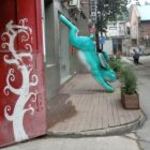Courtesy of Lindsey Dawson.
 Countries are often identified in strangers’ minds by what’s in tourist shops. In New Zealand it’s the tiki, the fern the koru and the colour green. For China we think of panda bears, pagodas, ornate fans and everything decked in red and gold.
Countries are often identified in strangers’ minds by what’s in tourist shops. In New Zealand it’s the tiki, the fern the koru and the colour green. For China we think of panda bears, pagodas, ornate fans and everything decked in red and gold.
But there’s much more to all of us than those glib images. Art thrives everywhere and in China it pops up in surprising places. Example: the 798 Art Precinct in Dashanzi, an enormous area in central Beijing that started life as a grey, East German-built 1950s factory complex.
Up to 20,000 people once worked and lived here churning out electronics and equipment for the People’s Liberation Army. On the surface it still feels like a factory zone with its chimneys, gantries, old engines and grim exteriors.
Its website, www.798space.com , has a few committee-speak phrases like one describing the precinct as “the past, present, and future of the ‘New China’ and the unique meaning of the socialistic culture”.
But it doesn’t feel socialistic as much as creative and alive. By the 1990s the factories had become obsolete and were closed down. Ten years ago, artists began to rent and divide up the abandoned concrete buildings and old sheds and now you can wander all round the site to discover a host of lively galleries and shops full of the work of local artists, ranging from traditional prints to cutting-edge graphics.
There are silk stores and fashion designers, bookshops, high-end tailor shops, graphic-art studios and architects’ offices. Huge outdoor sculptures include towering Transformer-type figures and looming fantastical insects perched on rooftops. 
Look up in one soaring exhibition hall to see red characters extolling the virtues of Chairman Mao. They were daubed on the curved concrete ceiling during the Cultural Revolution of the 1960s and still there today, retained for posterity. But stroll along the street and you can order really good coffee and food in funky bars and cafes that would fit into Soho or Sydney, at prices you’d pay in Auckland.
These days Dashanzi is often billed as the centre of Beijing’s “BoBo" (bourgeois-bohemian) quarter. You can spend hours walking its labyrinth of streets and squares, so wear comfy shoes. Entrance is free.
With real estate worth astronomical prices in central Beijing, not everyone is confident of the future of this area. It’s currently designated an official ‘special art zone’ but given its position between downtown and the city’s biggest airport, it may not last. If you’d like to see this example of post-industrial chic, it may pay to do it soon.
Air New Zealand flies direct to Shanghai five times weekly.
For further information and to book visit www.airnewzealand.co.nz








Join the Discussion
Type out your comment here:
You must be logged in to post a comment.